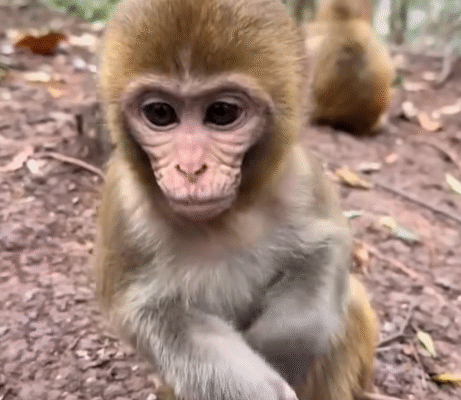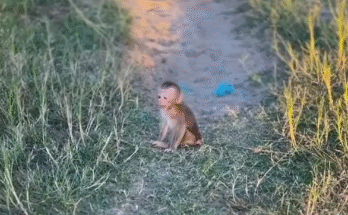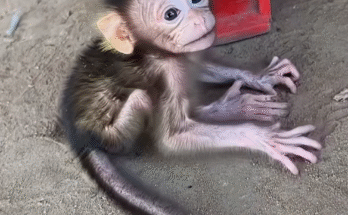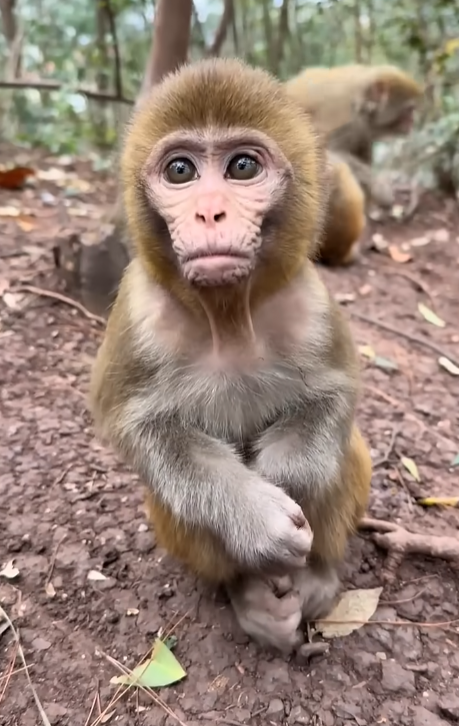
The sun had barely climbed above the treetops that morning when the troop of monkeys gathered near the forest edge. This was their favorite place—close enough to the jungle for safety, but just near enough to the village trails where humans occasionally passed by with snacks, fruit, and other interesting treasures. And among this troop lived some of the most dramatic, expressive monkeys anyone could imagine.
If one thing was absolutely certain, it was this:
They knew how to make a face to get food.
And they were experts at it.
It all started with a clever little monkey named Nobi. Nobi had learned early in life that humans were surprisingly weak when it came to emotional expressions. Humans could resist a monkey staring at them… but a monkey making a cute, pleading face? Impossible.
One day, Nobi watched a tourist open a bag of mango slices near the benches. Instead of begging loudly like the others, Nobi approached slowly. Then, right as the tourist looked down at him, he widened his eyes, drooped his ears, and puckered his lips in the tiniest, most pitiful pout.
The tourist burst into laughter.
“Oh my gosh, look at him! He wants it so badly!”
Within seconds, Nobi had mango slices, grapes, and whatever else the amused humans could find. The other monkeys didn’t understand how he got so much food with so little effort. But Nobi was proud. He’d discovered the power of acting.
And just like that, a new “skill” spread across the troop.
The Art of Expression
Soon, the forest clearing was full of dramatic monkeys—each one competing to make the funniest, cutest, or saddest face.
There was Mimi, the queen of wide-eyed innocence. She had huge, round eyes that she’d widen as if she had just seen the most tragic event in the world. With her tiny hands pressed together as if begging, she looked like she was praying for mercy. Humans melted instantly.
Then there was Koko, who mastered the “I’m starving” look. He would sit very still, shoulders hunched, lower lip sticking out, eyes half-closed like he hadn’t eaten for a week (even though he just finished stealing two bananas). Humans always said the same thing:
“Oh no, poor baby! Here, take some food.”
Koko would grab it and run before they realized he was a fraud.
But the most dramatic of all was Lola. Lola treated every feeding opportunity like a theater performance. She made faces so exaggerated that even the other monkeys stared at her. She could switch from crying-face to excited-face in half a second flat. She tilted her head, blinked slowly, and pressed her tiny palms to her cheeks as if she were deeply touched by kindness.
Humans adored her. Phones came out instantly. Photos, videos, laughter—everybody wanted a clip of the “emotional monkey.”
And of course, she always got food.
The “Food Stand” Area
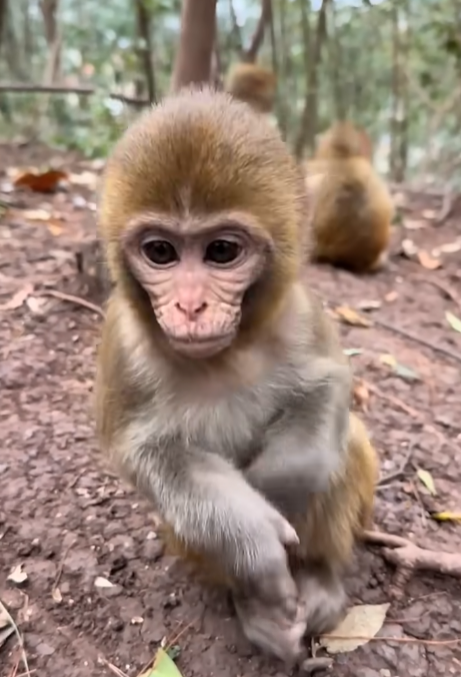
The monkeys eventually figured out that humans tended to stop at one specific spot: a shaded rest area with two wooden benches. It wasn’t an official feeding area, but the monkeys didn’t care. They called it, in their own way, “the food stand.”
Every day, the troop positioned themselves strategically:
- The cute ones sat closest to the benches.
- The babies were placed in the front as living bait.
- The dramatic actors took the sides, ready to perform at the slightest rustling of a snack bag.
- The bold thieves hung from the branches above, ready to swoop down if necessary.
It became an organized system—almost professional.
When visitors walked by, the monkeys perked up instantly. Faces changed. Eyes widened. Cheeks inflated. Lips quivered.
Some monkeys practiced their expressions beforehand, making exaggerated faces at each other until they were satisfied with their performance. Baby monkeys mimicked their mothers, learning the art from a young age.
Even wild monkeys, it seemed, understood that comedy and cuteness could bring rewards.
The Day of the Spicy Surprise
One afternoon, a young man arrived with a backpack full of snacks. The monkeys watched closely—this visitor looked generous.
Nobi led the greeting party, making his famous sweet face. Mimi widened her eyes until she looked like a cartoon character. Koko dragged his feet dramatically, pretending he could barely stand from hunger.
The man laughed, charmed by the troop’s antics.
He reached into his bag and pulled out a paper packet. The monkeys leaned forward eagerly. But then came the twist…
The packet contained spicy potato chips, the kind humans struggled to eat without sweating. But the monkeys didn’t know. They saw food and assumed it was delicious.
The man broke a chip and offered a piece to Nobi.
Nobi took it proudly.
He sniffed it.
He licked it.
Then he took a full bite.
And instantly regretted it.
His eyes bulged. His head snapped back. His mouth opened wide as he began flapping his hands frantically. He shook his head so fast it looked like a blur. Mimi screamed in alarm. Koko fled behind a tree. Lola gasped dramatically—though somewhat admiringly, as if impressed by Nobi’s new “performance.”
The man, horrified, quickly offered water.
Nobi snatched the bottle, poured water straight onto his tongue, and stared accusingly at the chip bag like it had betrayed him. For the rest of the day, he refused to take food from anyone unless he sniffed it at least three times.
The troop never forgot the lesson:
Some faces get food. Some foods are traps.
The Babies Join the Game
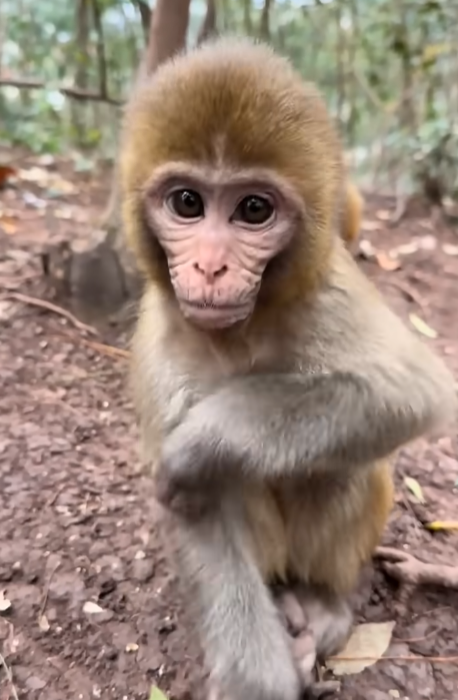
Baby monkeys eventually became the ultimate weapon. Their natural cuteness required no acting, but they still practiced making faces by imitating adults.
Little Bobo learned the “puppy eyes” trick perfectly. Whenever a tourist approached, he waddled forward, tilted his head, and gave a tiny squeak. Humans melted instantly.
Baby Lili developed a shy-face routine—peeking from behind her mother, slowly lowering her head, then giving a tiny smile. Humans offered her everything: peanuts, bananas, even whole sandwiches.
The troop leaders were proud. Their young ones were learning… even if what they were learning was a kind of adorable manipulation.
Their Secret Talent
What made their behavior so funny was that monkeys didn’t just make faces—they understood the reaction. They knew which expression worked on which human:
- Serious adults responded best to sad faces.
- Kids responded to funny or exaggerated faces.
- Elderly visitors loved shy, gentle expressions.
- Couples adored baby monkeys the most.
The troop adjusted their performance based on who showed up.
Monkeys were not just making faces—they were strategic.
The Finale: Too Much Drama
One day, Lola delivered her most dramatic performance ever. She approached a woman holding a banana and made her saddest face: trembling lips, drooping shoulders, head tilted at the perfect angle.
And it worked—the woman smiled warmly and held out the banana.
But before Lola could take it, another juvenile monkey jumped in to grab it.
Lola froze.
Her face slowly transformed from sad…
to shocked…
to furious…
to dramatically heartbroken.
She collapsed onto the ground like a disappointed actress. She covered her face with both hands, peeking occasionally to see if the woman was watching.
The humans burst into laughter.
And yes—Lola got two bananas as compensation.
In the end, one thing remained absolutely true:
These monkeys weren’t just smart—
they were master performers.
They knew exactly how to make a face to get food—
and every day, their audience kept coming back for more. 😅🐒
